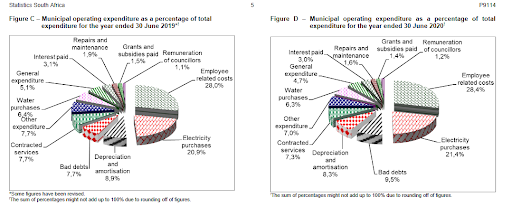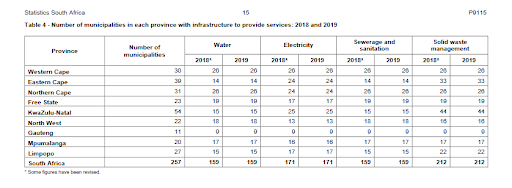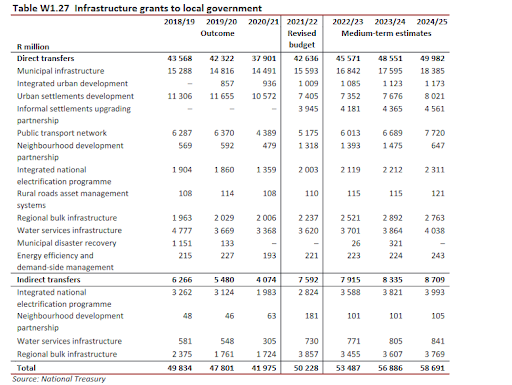What Are Asset Maintenance Management Plans?
To combat poor levels of service delivery, maintenance plans were developed to ensure that infrastructure remained efficient and usable. Asset maintenance management plans - also known as immovable asset management plans or infrastructure maintenance plans - are strategic outlines for the repair and maintenance of local infrastructure, such as public works for water and sanitation, transport and energy. Municipalities are required to compile plans and budgets for three different kinds of maintenance: periodic fixes, emergency maintenance (in the case of natural disasters), and sometimes major rehabilitation, replacement or even demolition.
Why are Asset Maintenance Management Plans Important?
Infrastructure/ asset management and maintenance is a vital part of enabling effective service delivery, economic growth, social development, and an improved quality of life for all South Africans. For example, better roads and transport facilities allow people to access more job opportunities in different areas, thereby improving income inequality. Improved electricity supply leads to better education and more productivity. Water supply allows for better national nutrition and prevents waterborne diseases from thriving. Advanced telecommunication networks allow for improved business and commercial activities that increase profits and GDP.
Asset maintenance management plans are necessary to mitigate damage and disrepair for vital public works. While the initial planning, design, construction and implementation phases of infrastructure development are important, it should be understood that at least half of the budget allocated for these assets should be spent after commission and construction. Generally, emphasis is placed on infrastructure development and delivery. However, many seem to forget that infrastructure delivery refers to the entire lifecycle of immovable assets - this refers not only to the planning and construction of infrastructure, but also to the appropriate operation and maintenance thereafter.
Who is Responsible for Asset Management and Infrastructure Maintenance?
South African municipalities provide a wide range of asset based services to businesses, government institutions, social institutions and households. These services should ensure social health and well-being, while supporting economic growth. This responsibility is conferred to municipalities by the Constitution and various legislation. Municipalities manage the following:
- Potable water and sanitation services
- Roads and stormwater drainage systems
- Electricity supply & community safety facilities
- Solid waste management and street cleaning
The following legislation reflects the expectation that municipalities should be held responsible for asset maintenance.
- Section 96 of The Municipal Finance Management Act, 2003, Act 56
- The Water Services Act, 1997 (Act 108 of 1997)
- Section 84 of The Local Government Municipal Structures Act 1998
- Government Immovable Asset Management Act, Act 19 of 2007
- Schedule 4, Part B, of the Constitution of the Republic of South Africa, 1996 (Act No. 108 of 1996)
How Are Assets Managed and Maintained in Reality?
Municipalities are still experiencing challenges and backlogs with service delivery as a result of poorly developed and maintained public works. In 2021, the Fiscal and Financial Commission reported that there is poor intergovernmental communication and consultation between financiers, local governments and other stakeholders when implementing infrastructure development and delivery plans.This in turn causes escalations in cost, irregular expenditure, delays and collapses in service delivery. As a result, more money is spent on constructing new infrastructure instead of optimising existing resources in profitable ways. Greater scrutiny has been placed on municipalities’ ability to maintain asset management on existing infrastructure.

The figures above show that repairs and maintenance are some of the lowest expenses of the municipalities. This table is taken from the Statistical Release P9114: FInancial Census of Municipalities for the year ended 30 June 2020.


The tables above, originally depicted in the Statistical Release P9115: Non-financial census of municipalities for the year ended 30 June 2019, show the discrepancies between municipalities mandated to supply basic services and the availability of infrastructure. Table 4 reflects that not all of the 257 municipalities have the necessary infrastructure to supply basic services. Table 5 reflects that not all municipalities are supplying these services, even when they do have the infrastructure to do so. This is often caused by maladministration, misuse of public funds and poor municipal management.
What are the Results of Poor Asset Maintenance?
Infrastructural asset management is a critical part of socio-economic development. Well-maintained infrastructure can improve social inequality and help to alleviate poverty. Without proper maintenance, infrastructure will fail and service delivery will collapse - this often affects the poor most severely, as indigent households rely on the state to provide free basic services, since private service provision is largely more expensive. However, low capacity for asset management, poor planning and oversight, lack of By-laws and legal compliance, conditional grant dependency and corruption are all causes for poor service delivery. Failure to address these issues has, consequently, caused citizens to lead service protests, destroy public property, interrupt services and lose confidence in municipal administrators.
For example, in a Ministerial Briefing Session, it was reported that 3 million households did not have access to reliable drinking water and 14.1 million people did not have access to safe sanitation facilities. Only 64% of households had access to reliable drinking water, while 41% of municipal water was lost due to leakage, causing losses costing approximately R9 billion annually. 56% of wastewater treatment works and 44% of water treatment works are in a poor or critical condition, and 11% of water treatment works are dysfunctional as a result of poor maintenance.
The implications of not properly caring for assets can also lead to: outbreaks of preventable diseases, environmental damage and economic disinvestment and lost opportunities with regard to potential investors.For example, KwaZulu-Natal recently had infrastructural damage estimated to cost R1.9 Billion as a result of flooding caused by torrential rains. Residents have blamed the municipality for their poor service delivery and management of stormwater drains in recent years, which were unable to prevent drains from flooding as a result of large influxes of rainwater. Had the stormwater drainage systems been properly managed and refurbished more regularly, perhaps the effects of the downpours would not have been so severe.
How Does the Government Allocate Funds for the Improvement and Maintenance of Strategic Infrastructure?
The Division of Revenue Bill makes provisions for The Municipal Infrastructure Grant as well as a variety of other conditional grants that aim to support local government service delivery. Conditional grants are monetary transfers from national government to provincial or local government. These funds supplement the equitable shares that municipalities receive, and they are given on the condition that provinces or municipalities use the money to deliver substantive results aligned with national objectives. The Municipal Infrastructure grant funds the provision of infrastructure for basic services, roads and social infrastructure for poor households in all non-metropolitan municipalities. The total allocations for this grant amounts to R52.8 billion over the medium term.
In 2021, the scope of the Municipal Infrastructure Grant was expanded to allow municipalities to use up to 5 percent of their allocation to develop Infrastructure Asset Management Plans, which is aimed at addressing the poor asset management in municipalities. To make use of this provision, municipalities will need to submit a business plan to the Department of Cooperative Governance, accompanied by a copy of its audited asset register.
Other conditional grants transferred to municipalities for infrastructure management and development are depicted below:

Does Each Municipality Have an Asset Management Plan?
According to the Minister of Cooperative Governance and Traditional Affairs, 75 municipalities across the country have a full spectrum of infrastructure maintenance plans. A total of 60 municipalities are fully implementing the infrastructure maintenance plans, and 18 municipalities are partially implementing their infrastructure maintenance plans. Only Limpopo and the North West do not have full-spectrum Infrastructure maintenance plans. Interestingly, KwaZulu-Natal has the highest number of fully-implemented full-spectrum maintenance plans. However, these plans are currently unavailable on public websites.
Which Institutions are Supporting or Enforcing Infrastructure Delivery Plans and Maintenance Plans?
National Treasury’s Local Government Capital Asset Management Guideline states that ,“the responsibility for assisting and supporting local government in implementing reforms on asset management rests with National Treasury, the Department of Provincial and Local Government and sector departments.” Below are some of the sectoral departments responsibilities with regards to supporting municipal asset management.
- The Department of Water and Forestry supports municipalities with water and sanitation infrastructure.
- The Department of Public Works and Infrastructure supports municipalities with infrastructure such as public facilities, land and buildings.
- The Department of Minerals and Energy supports municipalities with electricity infrastructure
- The National Department of Transport supports municipalities with roads and stormwater systems
- The Department of Environmental Affairs and Tourism supports municipalities with infrastructure for solid waste.
- Municipal Infrastructure Support Agency offers strategic and technical support to municipalities by providing administrative and organisational guidance. They are overseen by the Department of Cooperative Governance.
Who Is Responsible for Planning and Execution?
National Treasury recommends that municipalities create Asset Management Steering Committees, which should be led by Municipal Managers/ Mayors, Chief Financial Officers, Chief Engineers, Integrated Development Plan Managers, Asset Managers, Internet Technology Managers and Services Managers. This Committee would lead by planning and preparing asset management projects and timetables. They would then consult with Asset Management Project Teams, who are responsible for preparing financial forecasts and coordinating the activities. The Project Team would then delegate to the Asset Management Task Team, whose duty would be to implement the plan, collect the relevant data and analyse the progress. All of this work should be overseen by municipal managers, supporting institutions such as MISA, COGTA, and the relevant sectoral departments listed.
What Does Civil Society Believe are the Causes of Poor Maintenance?
In this article from October 2021, experts discussed corruption in local government in a webinar hosted on YouTube. The panelists noted that poor service delivery and infrastructure deterioration is caused by a variety of issues, including but not limited to poor financial accountability, inefficient municipal auditing, the misuse of public funds, poor coordination between the three levels of government, incompetent municipal councillors, a lack of training for administrators and a lack of oversight from supporting institutions such as the Department of Cooperative Governance and Traditional Affairs.
In this article, experts identified that there was, “a lack of professional workplace experience among councillors and lack of skills as a major challenge facing municipalities. He cited revelations by the South African Local Government Authority (SALGA) that 66% of councillors have no post-matric qualifications and that 62% can’t use a computer as major indicators of a sector in trouble.” This is why it is vital for the public to monitor municipal asset management. Through lobbying efforts and petitions, citizens can contest the deterioration of assets, maladministration, corruption or negligence.
Who Can You Contact For Provincial Infrastructural Complaints?
- +27 40 602 4000
- Free State - +27 51 492 3815-
- Gauteng - +27 11 355 5855
- KwaZulu-Natal - +27 33 355 5500
- Limpopo - +27 15 284 7000/1
- Mpumalanga - +27 13 766 6696
- Northern Cape - +27 53 839 2100
- North West - +27 18 388 4451
- Western Cape - +27 860 142 142


Comments
Keep comments free of racism, sexism, homophobia and abusive language. People's Assembly reserves the right to delete and edit comments
(For newest comments first please choose 'Newest' from the 'Sort by' dropdown below.)